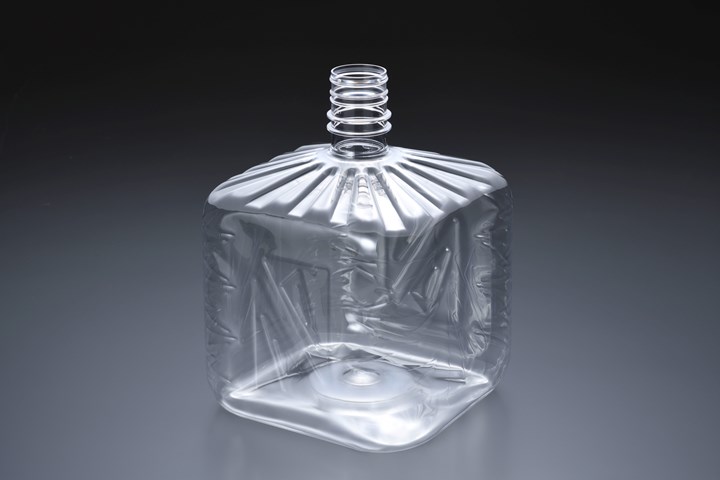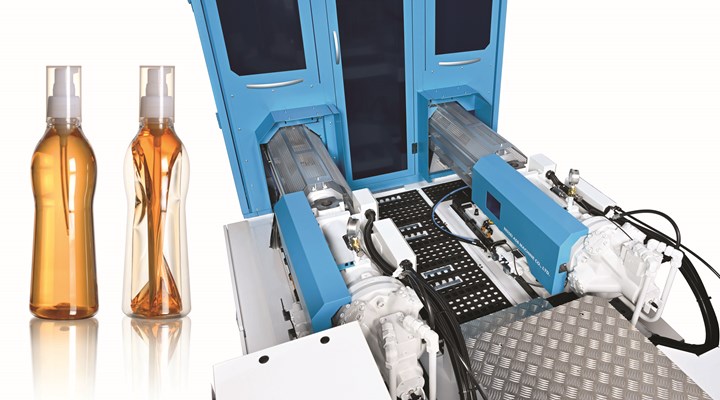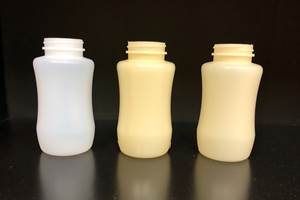Modified Machines to Mold Unusual PET & PP Bottles at K 2022
K 2022 visitors looking for new ideas in stretch-blown containers will be treated to two novel collapsible concepts a the Nissei ASB booth.

Thinwall 12 L ‘bag-in-box’ water bottle collapses as it empties inside a carboard outer container. It weighs only 120 g. (Photo: Nissei ASB Co.)
New machine versions will be shown for the first time producing novel stretch-blow molded containers by Nissei ASB Machine Co., Ltd. at next month’s K 2022 show in Düsseldorf. An existing machine will also produce an optimized returnable/refillable PET bottle, and a new size of injection press will produce PET preforms.
Two collapsible container designs top the news at this booth. The first is a 12-liter “bag-in-box” style PET container for home water dispensing machines. This square collapsible bottle fits inside a cube-shaped cardboard carton, both of which are fully recyclable. The thinwalled bottle weighs only 120 g in the 12 L size (also available in 9 L), amounting to just 10 g of PET per liter of water—about half the plastic-to-water ratio of the lightest conventional water bottles from 500 ml to 2 L size. The collapsible nature of the bottle keeps the contents pure by eliminating entry of ambient air as the bottle empties.
This product will be molded at the show on a PF36/9-12000 1.5-stage injection stretch-blow (ISBM) machine, a further development of ASB’s PF36 series, which is said to combine the best elements of one-stage and two-stage systems into a highly compact system. Since the preform injection molding step typically takes around three times longer than the stretch-blowing stage, this machine molds nine preforms while bottles are blown three-up, saving on tooling cost. Output of the 12 L collapsible bottle is 1540 bph.

Twin injection units mold a collapsible inner PP layer and stiff PET outer layer for an airless pump-spray bottle that protects the contents from contact with ambient air. (Photo: Nissei ASB Co.)
The second novel design is an airless pump dual-layer spray bottle that also prevents ambient air from contacting the liquid contents. In this case, a thin inner layer of PP easily delaminates from the outer wall of PET and collapses as the contents are dispensed. Thus, virtually no headspace develops inside the bottle. PP has the added benefit of greater moisture barrier than PET.
At the show, a 300-ml airless pump bottle will be molded with 22.8 g of PET and 5.7 g of PP at a rate of 410 bph. The ASB-12M-2INJ machine is based on the company’s best-selling ASB-12M model, modified with twin injection units and a six-station rotary table that comprises two separate injection and cooling stations. By adding two sets of lip-plate assemblies and a replacement hot runner, mold sets produced for standard single-layer PET molding on ASB-12M machines can be utilized on this machine. An alternative use would be molding dual-layer PET bottles with the inner layer of virgin PET and the outer layer (70% of the total PET thickness) of rPET flake.
The third stretch-blow molding exhibit uses the firm’s established HSB Series double-blow, heat-set reheat machine to make a 1 L returnable/refillable PET bottle, a product much more widely used in parts of Europe and Latin America than in North America. In this case, the bottle is said to surpass current industry standards with a 53-g weight (vs. the current standard of 62 g); 1.5 gas volume (compatible with the German industry standard for sparkling water); greater than 25 reuse cycles (vs. the industry standard of up to 25 cycles); and up to 30% rPET content with no reduction in performance. (In fact, lab tests show R&R bottles with 30% rPET actually achieved more than 30 washing and pressurization cycles.) An HSB-4N machine will mold 3060 bph.
For news in preform injection molding for two-stage bottle blowing, see the accompanying Injection Molding item.
Related Content
A Purge Solution for the Blow Molding and Compounding Industries
New commercial purge compounds for new industries from Chem-Trend.
Read MorePolyJohn Turns to Blow Molding, Doubles Its Productivity
Leading maker of portable sanitation products knew thermoforming, sheet extrusion, rotomolding and injection molding. Then it found the missing link to higher productivity and new markets: blow molding.
Read MoreFor Extrusion and Injection-Blow Molders, Numerous Upgrades in Machines and Services
Uniloy is revising its machinery lines across the board and strengthening after-sales services in tooling maintenance, spare parts and tech service.
Read MoreHow to Extrusion Blow Mold PHA/PLA Blends
You need to pay attention to the inherent characteristics of biopolymers PHA/PLA materials when setting process parameters to realize better and more consistent outcomes.
Read MoreRead Next
Lead the Conversation, Change the Conversation
Coverage of single-use plastics can be both misleading and demoralizing. Here are 10 tips for changing the perception of the plastics industry at your company and in your community.
Read MoreFor PLASTICS' CEO Seaholm, NPE to Shine Light on Sustainability Successes
With advocacy, communication and sustainability as three main pillars, Seaholm leads a trade association to NPE that ‘is more active today than we have ever been.’
Read More










